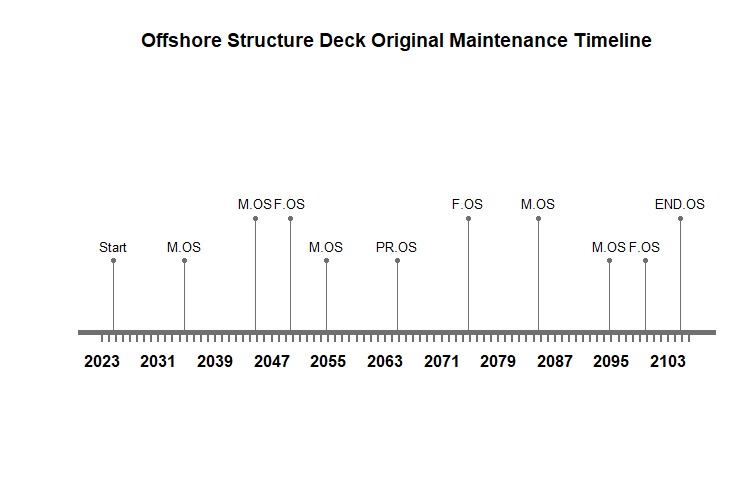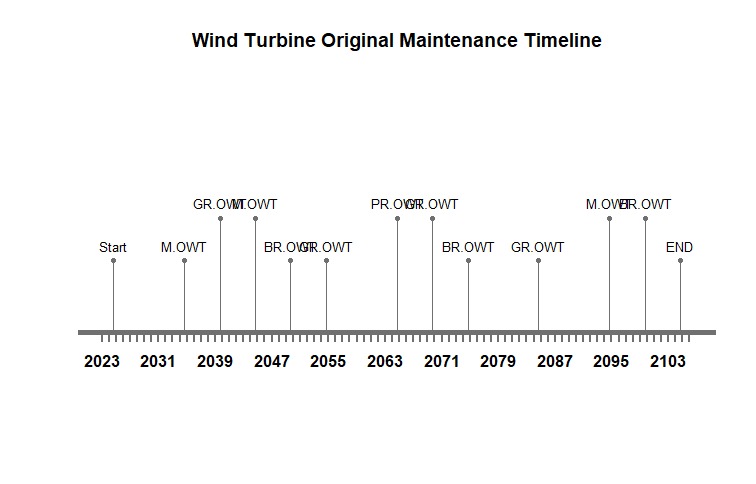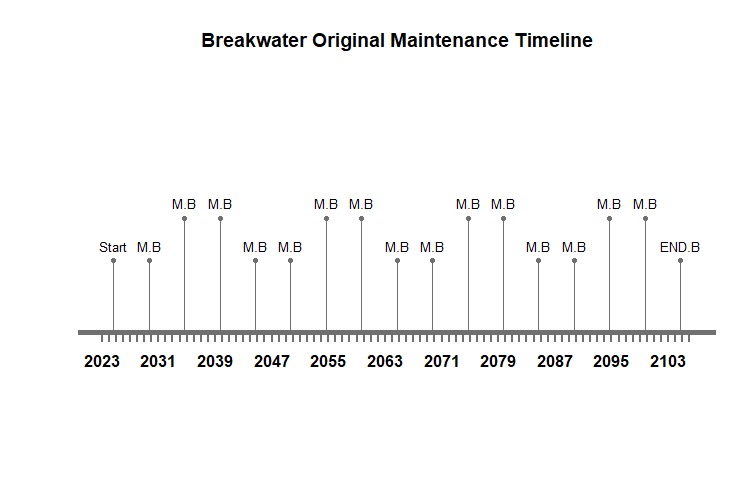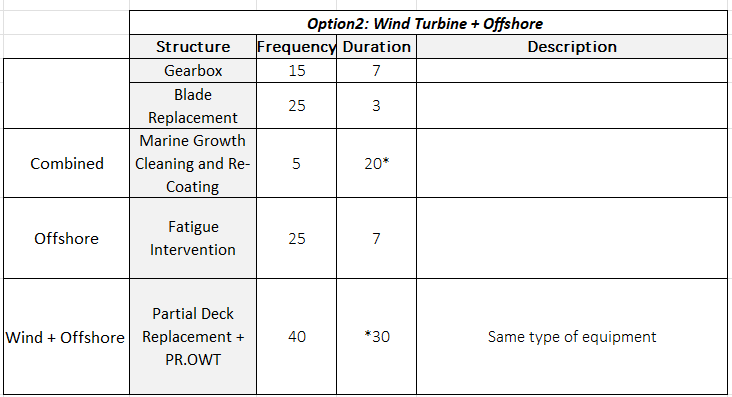4. Integrated Maintenance Strategy
When designing an integrated system that considers the interactions between its components, we developed a maintenance strategy that optimizes interventions and reduces costs by leveraging these synergies. The main considerations are:
- Lower corrosion maintenance for wind turbines: The relocation of the turbines to the breakwater reduces their exposure to seawater, significantly decreasing corrosion-related maintenance efforts.
- Reduced structural fatigue for wind turbines: Since the wind turbines are no longer directly in the water but are installed on the breakwater, the jacket structure experiences lower fatigue. It only needs to withstand wind loads, not wave loads, which reduces maintenance requirements and allows for smaller structural dimensions.
- Breakwater protection for offshore structures: The breakwater creates calm water zones, reducing wave action on offshore structures. This influences the structural design (materials and dimensions) and decreases the frequency and duration of fatigue-related interventions.
- Improved accessibility for maintenance: The breakwater facilitates vehicle access for wind turbine maintenance, reducing both time and costs. Additionally, it ensures calmer sea conditions for ship-based maintenance of offshore platforms, minimizing the impact of wave height on operational activities.For the comparison of estimated labor costs savings please see the Integration Context, improved maintenance operations.
Baseline maintenance strategy
As a reference, Table 1 presents a baseline maintenance strategy, which considers the breakwater’s protective role and its impact on maintenance operations. However, this approach does not take advantage of the potential efficiencies gained through system integration in terms of logistics and resource optimization. Thus, while the breakwater already contributes to reducing loads and intervention durations, maintenance operations are still planned independently for each system, without synchronization. For the original timelines the total duration of the maintenances are 211 days.
Proposed Optimization Strategies
To further enhance the maintenance strategy and achieve the goal of minimizing the number and duration of interventions while ensuring structural integrity, we propose two optimized alternatives:
Alternative 1: Combined Marine Growth Maintenance
Building upon the previous alternative, this approach optimizes maintenance actions related to marine growth removal and protective coatings, which are essential for all three systems. Instead of performing these tasks separately, they are now planned as a combined operation:
- The maintenance interval for breakwater surface cleaning has been extended from 5 to 10 years. While this increases the amount of material to be repaired during each intervention, the breakwater’s infrastructure facilitates logistics, ensuring the availability of vehicles, personnel, and materials for simultaneous maintenance of the wind turbines.
- Wind turbine maintenance is scheduled to align with breakwater cleaning, optimizing access and reducing redundancy in logistics.
- Offshore platform maintenance can be conducted in parallel, as there is no operational interference between the tasks.
- The actions require similar material and equipment for protective coatings and structural repairs because they are constructed of concrete and steel.
For the Integrated Maintenance Option 1 the total duration of the maintenances are 166 days.
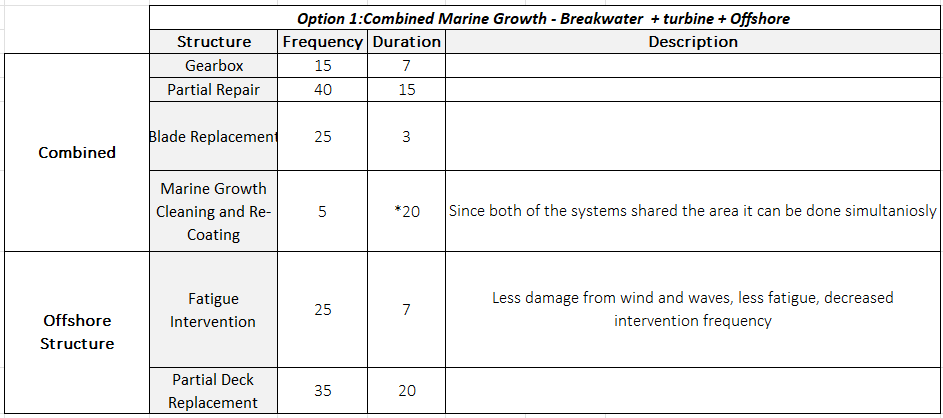
Alternative 2: Combined Partial Replacement
Partial deck replacement is a necessary maintenance activity for offshore platforms. Given the integration of multiple systems in this project, it is proposed to synchronize deck replacement interventions for both offshore structures, optimizing maintenance efficiency and reducing operational disruptions:
- By aligning the Partial Deck Replacement (PDR) schedules, material procurement, workforce allocation, and equipment usage can be optimized. Offshore platforms require vessel mobilization, while wind turbine maintenance typically relies on land-based vehicles. Synchronizing these activities ensures that resources are used efficiently without interference, leading to cost savings in logistics and manpower allocation.
- Offshore wind turbine maintenance (PR.OWT) can also be integrated into this intervention period, ensuring that all systems undergo major structural work within the same timeframe. This combined approach reduces separate mobilization efforts, enhancing operational planning and minimizing downtime.
- A planned duration of 25 days is considered for this combined intervention, reducing downtime while ensuring operational efficiency. Additionally, the integration of breakwaters within the offshore environment provides structural protection against wave loads, reducing fatigue stress and corrosion rates on both wind turbine monopiles and offshore platforms. Research indicates that placing offshore structures within breakwater zones can extend monopile fatigue life by up to 30% by mitigating wave-induced oscillations and current-induced vibrations (MDPI, 2023).
This approach significantly improves structural longevity, minimizes environmental stressors, and reduces the frequency of major interventions. The controlled hydrodynamic conditions provided by breakwaters also slow material degradation, leading to lower maintenance costs over time. By combining offshore deck replacement with wind turbine maintenance in a breakwater-protected zone, operators can ensure long-term asset reliability, operational efficiency, and reduced overall maintenance expenses.
For the Integrated Maintenance Option 1 the total duration of the maintenances are 146 days.
